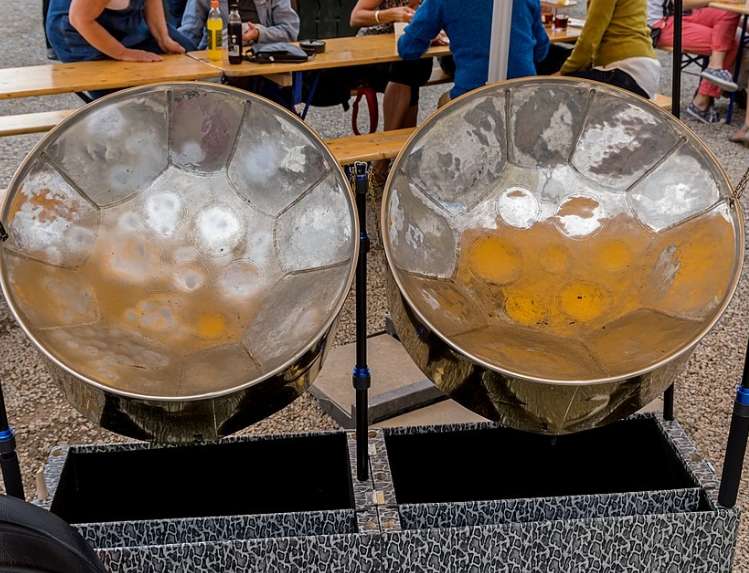Trinidad & Tobago Drumming Out Colonial Relics.
– Advertisement –
The government of Trinidad and Tobago recently had a public meeting with residents of the twin islands which lie just off the coast of South America if they support the removal of statues, signs and monuments with colonial ties, what should be done with them, and whether alternatives symbols or focus points should be erected in their place.
This came just a week after Prime Minister Keith Rowley announced that his government would withdraw and redraw the national coat of arms to remove Christopher Columbus’ three famous ships — the Pinta, the Niña and the Santa María – and replace it with the steelpan, a popular percussion instrument originally made from oildrums that originated in the Caribbean nation.
Some people have pointed out, with good reason that the ships depicted on the coat of arms were those Columbus used on his first voyage to the Caribbean, not his third voyage in 1498 when he reached Trinidad.
But phasing out the existing symbol, which was designed by local artists in 1962 to mark the country’s independence from the United Kingdom, could realistically take years. The present version is everywhere: on every banknote, every passport, every naval vessel, and every official government document.
The steelpan was named the national instrument after the National Musical Instrument Act 2024 was passed last month, but even then the steelpan is not universally approved as it has stronger connections with Trinidad’s Afro-Caribbean community and less weight with the Indian-Caribbean group who form a similar percentage of the population.
At a public meeting people of African, Indian, European and Indigenous descent came forward to offer their opinions about what to do with the statues.
There was no unanimity.
One man suggested that the prominent Columbus statue in a public park be placed indoors in a museum.
Another idea was to create an outdoor park of infamy where all the colonial figures should be grouped so that people could come and mock them.
Strangely, no one suggested that they should be shipped overseas and sold at auction.
However the overall majority of speakers and online commenters favoured doing away with the statues.
“It’s an issue about how after 62 years of independence … we continue to live in a space that reflects the ideals and the vision and the views of those who were our colonial masters,” said Zakiya Uzoma-Wadada, executive chair of the islands’ Emancipation Support Committee.
Trinidad and Tobago is the latest nation to embrace a global movement that began in recent years to abolish colonial-era symbols as it reckons with the past.
This movement is not confined to the Caribbean former colonies. In England statues and memorials to former slave owners have been desecrated and destroyed. In the US there has often been opposition to public statues from the Civil War era, especially those of military leaders who fought to continue slavery in the South.
The public hearing was held just a week after the government announced it would redraw the nation’s coat of arms to remove Christopher Columbus’ three famous ships — the Pinta, the Niña and the Santa María – and replace it with the steelpan, a popular percussion instrument that originated in the Caribbean nation.
“What the hell is the queen still doing on top of the coat of arms? Please let us put her to rest,” said Eric Lewis, who identifies as a member of the First Peoples, also known as Amerindians.
Trinidad and Tobago was first colonized by the Spanish, who ruled it for nearly 300 years before ceding it to the British, who governed it for more than 160 years until the islands’ independence in 1962. The colonial imprint remains throughout streets and plazas, with a statue of Christopher Columbus dominating a square of the same name in the capital of Port-of-Spain.
The islands’ National Trust calls it “one of the greatest embellishments of our town,” but many differ.
“It’s disrespectful to those who were the victims of him. The people suffered tremendously,” said Shania James as she called for the statue to be placed in a museum. “His atrocities should not be forgotten.”
But a handful of people dismissed concerns about how their ancestors were treated, including tour guide Teresa Hope, who is Black.
“They survived, and I survived, and we will keep on moving,” she said, adding that if the actions of historical figures were scrutinized, “everything would get knocked down.”
Rubadiri Victor, president of the Artists’ Coalition, said his country should instead erect statues and monuments to honor some of the more than 200 Trinbagonians who represent the best of the islands.
“We stumbling and tripping over heroes,” Victor said. “To have produced so much genius, and that lineage is nowhere present in the landscape.”
Among the suggestions of people to honor was Nobel Prize-winning author V.S. Naipaul; CLR James, a historian and journalist; and Kwame Ture, who helped spearhead the Black Power movement in the U.S.
Others suggested that prominent Amerindians and more local women be honored, including Patricia Bishop, an educator and musician and Beryl McBurnie, a teacher credited with promoting and saving Caribbean dance.
The debate is still not over in Trinidad and Tobago, and suggestions are still coming in.
Sources: AP, T&T Newsday, The Times.
– Advertisement –


